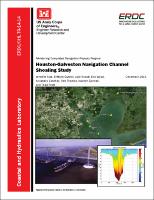Please use this identifier to cite or link to this item:
https://hdl.handle.net/11681/7383| Title: | Houston-Galveston Navigation Channel shoaling study |
| Authors: | Tate, Jennifer N. (Jennifer Noelle), 1978- Gunkel, Brittany L. Rosati, Julie Dean Sanchez, Alejandro Ganesh, Naveen B. Pratt, Thad C. Wood, Eric J. Thomas, Robert C. |
| Keywords: | Monitoring Completed Navigation Projects (MCNP) Adaptive Hydraulics (AdH) Coastal Modeling System (CMS) Particle Tracking Model (PTM) Houston Ship Channel (HSC) Texas Navigation channel shoaling Dredge disposal Waterways Dredging Monitoring Completed Navigation Projects Program (U.S.) |
| Publisher: | Coastal and Hydraulics Laboratory (U.S.) Engineer Research and Development Center (U.S.) |
| Series/Report no.: | Technical Report (Engineer Research and Development Center (U.S.)) ; no. ERDC/CHL TR-14-14 |
| Abstract: | The Monitoring Completed Navigation Projects (MCNP) program evaluates the performance of civil works navigation projects to advance coastal and hydraulic engineering technology and guidance. Monitoring is designed to understand how well projects are achieving their design goals to ultimately develop more accurate and cost-effective engineering solutions for US Army Corps of Engineers (USACE) coastal and hydraulic problems. Through the MCNP, design criteria and methods, construction practices, and Operation and Maintenance (O&M) techniques are improved. The monitoring program also identifies where present technology is inadequate or where additional research is required. The Houston-Galveston Navigation Channel (HGNC) MCNP study was initiated in 2009 to determine the causes of an unanticipated increase in channel shoaling, which occurred after deepening and widening was completed in 2005. Commercial traffic in Galveston Bay began in 1837 through a shallow natural channel. Recent deepening and widening of the Houston-Galveston Navigation Channel was authorized to accommodate larger vessels and meet safety and efficiency requirements of the Port of Galveston and Port of Houston. When designing the most recent channel improvement, the USACE Galveston District calculated future shoaling and the associated required placement area capacity based on historical O&M data. The District anticipated that the trends from 1948-1995 would continue and the only increase in O&M dredging would be caused by the lengthening of the channel offshore. The final design estimated 1.42 Million cubic yards (Mcy) per year maintenance dredging for the 45 ft x 530 ft channel, whereas the actual has been estimated by some methods to be much more. Nine hypotheses were developed to explain the unanticipated increase in navigation channel shoaling after channel improvements. These hypotheses were tested through historical analysis, field data collection, and numerical modeling. Goals of the study were to determine why the HGNC is shoaling more than anticipated by the pre-enlargement analysis and planned disposal practices as well as to develop standards to aid future channel enlargement O&M plans. These methods were based on analytical computations, modeling, and field data analysis. |
| Description: | Technical Report |
| Gov't Doc #: | ERDC/CHL TR-14-14 |
| Rights: | Approved for public release; distribution is unlimited. |
| URI: | http://hdl.handle.net/11681/7383 |
| Appears in Collections: | Technical Report |
Files in This Item:
| File | Description | Size | Format | |
|---|---|---|---|---|
| ERDC-CHL-TR-14-14.pdf | 8.48 MB | Adobe PDF |  View/Open |